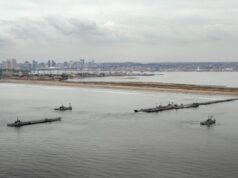
As the U.S. Navy-Marine Corps team looks to the future, it faces the need to balance and integrate the pressures of new technology, evolving political realities, and the enduring priorities dictated by the nature of the earth itself, with its surface covered 71 percent by water. The sea services must also fit the dictates of a very American constraint: the national preference for exerting power overseas on an expeditionary basis.
Geography imposes the planning dimension least likely to change for the Navy. America’s basic need for a naval force comes from our essential nature as a maritime power. Americans are often apt to forget it, but we are effectively a continent-size island lying between the bustling precincts of Asia, Europe, and South America, with extraordinary stretches of coastline in the temperate zone, accessible year-round. We derive much of our strength and influence from trading with almost everyone on earth. Yet for the United States, only Canada and Mexico can be accessed for trade without crossing the sea, and even with those contiguous neighbors, the sea is in many cases a more convenient or cost-effective option.
In the last century, the global seas have needed the United States for many things. But America, in her turn, needs the sea, and subsists in its environment for basic security as well as for resources and trade.
The First Priority
For this reason, the first priority of the U.S. Navy is sea control, on a vast scale unmatched by the needs of any other nation. Absolute control over the sea is not possible, of course. But we must be able to use the sea ourselves, and maintain cognizance of activities on the seas around us, with the power, when necessary, to interdict and exercise a veto over them.
With very long coastlines to protect, and two great oceans to patrol, America’s homeland defense is as much a maritime as an air and space problem, and in some ways more. The priority of sea control, in the conditions of current technology, means the core of America’s Navy will continue to be multipurpose combatants with formidable capabilities. We vest these capabilities in cruisers and destroyers, making them moving envelopes of combat power. Air, surface, and sub-surface warfare; support for the Marine Corps; standoff land attack; ballistic missile defense; intelligence collection; operating support for Special Forces and special operations – cruisers and destroyers do it all.
To patrol our ocean security buffers the attack submarine force is equally essential, representing in its realm a moving envelope of combat power like that of its surface counterparts. Unlike most submarine forces, ours will never not need to operate over extraordinary ranges, even if someday it is less intensively manned.
Neither the surface combatants nor the attack submarines, nor the air reconnaissance assets that support them, can be everywhere at once, of course. The “patrol” concept in the open oceans is about displays of power and deterrence, tokens of the veto the United States can exercise over emerging threats. In addition to more traditional threats, our sea control forces today must increasingly consider unconventional concepts like sea-launched electromagnetic pulse weapons and drone swarms deployed from off our coasts.
America’s Operating Premise
Since World War II, however, the defense planning of the United States has focused largely on two other general conditions: the need to both field and defend against strategic nuclear forces, and the value of “defending forward” by promoting stability, quiescent conditions, and a balance of power abroad, especially in the Eastern hemisphere.
The second condition, defending forward, is the one that has given special importance for the Navy to aircraft carriers, amphibious ships and now the Littoral Combat Ship (LCS) and the new class of “small surface combatant” (SSC) intended to take on the missions once performed in the U.S. Navy by frigates. These are the platforms that perfect slices of forward-engagement missions – which by their nature are mostly about the land-sea interface of competing political interests – while cruisers, destroyers, and submarines shoulder the load of classic sea control wherever it is needed.
This second condition affects our planning and policy thinking through a small but significant set of filters that may be called “operating premises.” Two big ones, for example, which have changed character somewhat over time, are the state of technology and the relative significance to our national policy of alliances.
The Expeditionary Premise
A third, however – the focus of this essay – is an especially American operating premise. That premise, which has been with us from the earliest days of the Republic, is the enduring preference of the American people for using military power overseas on an expeditionary basis; i.e., with as light a footprint on someone else’s territory as possible, and as often as not, especially in our first 150 years, a “get-away” ship waiting offshore.
Acquiring territory in the Western Pacific from the Spanish-American War of 1898 introduced America to the custodianship of far-flung colonial territories. The globally disruptive character of World War II persuaded Americans to finally accept some level of military force stationed permanently on the territory of others. But in the last quarter century, and especially in the last decade, the consensus behind that post-1945 commitment has noticeably waned. The pendulum of public sentiment and electoral politics has been swinging back toward an older American consensus, one that favors not isolationism so much as an ability to act abroad with decision, at need, but without planting roots across the oceans that smack of occupation and even imperialism.
Perhaps the most important aspect of this American attitude is one we rarely give thought to. The expeditionary premise isn’t about limiting our options to small interventions or token demonstrations that may not get the job done for our national interests. Rather, it is about empowering expeditionary force itself to achieve the effects we desire. From Veracruz in 1847 to Grenada in 1983, Panama in 1989, and Iraq in 1991, U.S. policy has “scoped up” expeditionary force to fit the goals of our policy, rather than the other way around.
This expeditionary premise has implications for all the services when we are defending forward. The going-in proposition of U.S. expeditionary power is that, for the Army and Air Force in particular, we may like to retain basing rights if we can, but we have no intention of shouldering (or usurping) the burdens of sovereignty for the host nation. As for the combat elements of our Navy and Marine Corps, for the most part they will do what they normally do: come and go.
Future Challenges
It is because the United States is fundamentally a maritime power of exceptional size, and one that prefers to use force on an expeditionary premise, that we are unlikely to stop seeing the need for a very large navy, and a marine corps with a unique role.
Since the end of the Cold War, America uses the U.S. Army and Air Force mostly on an expeditionary premise too. Increasingly, the military services simply perform missions jointly, and expect to. But time, alliances, and technology have yet to obviate the special affinity of the sea services for expeditionary operations. Approaching foreign countries from the sea is fundamental to the conditions imposed by the earth itself, and an expeditionary premise is uniquely intrinsic to maritime operations. The question is not whether we will continue to perceive expeditionary force through the lens of the sea, but what we will see through that lens.
The Navy and Marine Corps are already at work on one prominent vision that augurs rapid change: the use of unmanned weapons platforms and the level of automated, artificial intelligence (AI)-enabled technology incorporated in our weapon systems. In some of its aspects, such as expendability (what the Navy is calling “attritability”), this effort promises to empower U.S. forces with cheaper, more plentiful assets and a more agile, distributable basis for information, situational awareness, and decision-making.
In another aspect, however, it carries special import for expeditionary operations. The expeditionary premise is essentially about achieving effects with as light a footprint as possible in terms of disruptive political reverberations. Americans tend to think of that as meaning how much, or whether, there are “boots on the ground.” But it also implies a specialized emphasis on rules of engagement, which are intended most basically to enable the defense of our own forces while retaining discretion over our responses, and retaining the initiative for our goals, and not the opponent’s.
In a declared war like World War II, the automated responses of AI-enabled weapon systems may suit our purposes. With expeditionary operations short of formally declared war, we are more likely to insist on human-in-the-loop command and control as a means of keeping the scope and purpose of the operations at the level we intend. Inherent in the expeditionary idea is not being drawn into a conflict bigger than the United States envisioned. It’s hard enough to avoid that when there is little automation of command, control, and weaponry, as we learned to our cost in Vietnam. AI-enabled and autonomous combat systems may in some ways make it harder, if we don’t take rigorous care in preparing for that possibility.
The future of our alliances is another key area with special significance for the sea services as an expeditionary arm. The reason is simple: few of America’s allies are equipped to contribute significantly to certain types of expeditionary operations (e.g., amphibious assault). The allies that are equipped tend to offer niche capabilities. Some capabilities, like mine warfare, are indispensable, especially given the persistent shortfalls in our own forces. On the whole, however, outside of long-maintained operational plans like that for the defense of South Korea, the U.S. Navy and Marine Corps must plan for resources and training that envision diverse, highly contingent levels of allied integration.
There is little point in complaining about this political reality, as allies have inherently different national priorities. It must simply be dealt with: reviewed and perhaps renegotiated as necessary. It is a major factor in our evolving view of the NATO alliance, for example, and one the Trump administration has been unusually energetic and determined about looking into.
Focusing on the Future
If there is a way to systematize the framing of future requirements across both allied and independent uses of force in “forward defense,” it may be categorizing them under umbrella headings. Three serviceable ones might be the following: chokepoint security, exerting pressure on rogue regimes, and the reemerging category of countering regional attempts at hegemonic area denial.
The last category may be the most interesting in the coming years. It is an old pattern, not a new one; we have little mental concept of it now because of the global maritime dominance of the British Empire and the United States over the last 300 years. But when it goes unchecked, it quickly becomes incompatible with political stability, and its effects reach much further across continents in a geopolitical sense than our cultural memories may recall.
The premier example of it today is China’s effort to build out “virtual territory” into the South China Sea and dominate the chokepoint belt in the whole region. But there are signs of a somewhat analogous effort being made by Russia to exert dominance in the Eastern Mediterranean through clients in Syria and Libya. Coupled with Russia’s unprecedented use of Iran in the last two years of the Obama administration, as a way-point for combat operations in Syria (e.g., bomber missions and cruise missile attacks), these developments toll a death knell for the Truman Doctrine, which posited “support [for] free people who are resisting attempted subjugation by armed minorities or by outside pressures.”
In Iraq, Syria, Lebanon, and Yemen, meanwhile, Iran is mounting a similar effort to surround and hold Israel at risk, through Mesopotamia and the Arabian Peninsula and Red Sea. Each case of attempted hegemony and area denial presents not just a geographic definition for threats to American interests (including secure and freely accessible chokepoints, and stability for our allies), but constantly evolving military technological threats. If our forces – or third parties’ – encounter supersonic or hypersonic missiles, it will probably be first in one of these areas. Our first encounters have already occurred there with some of Russia’s and China’s most modern air combat systems, and their front-line surface warships and submarines.
These national security problems are inherently about operating in a maritime environment, as much for area access, surveillance, and combat as for logistics. The sea services can’t look to the future without seeing them on the horizon and addressing them. Moreover, they are problems for which the American people will demand expeditionary solutions: bounded objectives (though not necessarily “small” ones), defined end-states, and departures. There is little appetite between Honolulu and Boston for establishing new bases overseas or acquiring, by force, new territory that needs administering.
Can the expeditionary premise yield military operations that can counter 21st century attempts at area denial and exclusionary hegemony, especially by Russia and China with their growing arsenals of highly lethal smart weapons? That’s a tall order to fill. As a day-to-day matter, it is likely to be the pressing question for the Navy and Marine Corps, but also for expeditionary operations and U.S. national interests in general.
Commander J.E. Dyer, USN, (Ret.) is a former Naval Intelligence officer turned blogger.





